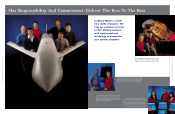Lockheed Martin 2001 Annual Report Download - page 16
Download and view the complete annual report
Please find page 16 of the 2001 Lockheed Martin annual report below. You can navigate through the pages in the report by either clicking on the pages listed below, or by using the keyword search tool below to find specific information within the annual report.
Lockheed Martin Annual Report >>> 23
Lockheed Martin Corporation
(Continued)
As a result, setbacks and failures can occur. It is important
for the Corporation to resolve performance issues related
to such programs in a timely manner to achieve success on
these programs.
The Corporation also conducts business in related com-
mercial and non-defense markets. Although these lines of
business are not dependent on defense budgets, they share
many of the risks associated with the Corporation’s defense
businesses, as well as other risks unique to the commercial
marketplace. Such risks include development of competing
products, technological feasibility and product obsolescence.
The launch vehicle industry continues to experience a
reduction in demand due primarily to delays in completing
certain satellite systems as a result of continuing overcapac-
ity in the telecommunications industry. Continued economic
uncertainty has adversely affected the capital markets and
has made it difficult for many ventures, especially telecom-
munications and other high-technology companies, to attract
the funding needed for new capital investment. Issues such
as these were evidenced in 2001 by the inability of Astrolink
International, LLC (Astrolink) to obtain additional funding to
complete a broadband satellite constellation. The Corporation
holds a 31% interest in Astrolink, and was under contract to
manufacture four satellites and to provide related launch
and other services. These contracts were terminated in the
fourth quarter of 2001 due to funding considerations.
Factors such as these have resulted in pricing pressures in
the launch vehicle marketplace associated with reduced
demand and increased competition. This comes at a time
when the Corporation is making significant investments in
the Evolved Expendable Launch Vehicle (Atlas V) program,
the Corporation’s next generation launch vehicle. This pro-
gram has required investment of funds for research and
development, start-up and certain other nonrecurring costs,
and launch facilities. A portion of these expenditures have
been funded under an agreement with the U.S. Government.
Orders to-date for the Atlas V launch vehicle have been
lower than expected, resulting in lower anticipated produc-
tion levels.
The above factors relative to start-up issues and delays
in completion of satellite systems also contributed to a
reduction in commercial satellite orders. In addition, similar
to the launch vehicle market, the commercial satellite mar-
ket is experiencing pricing pressures due to excess capacity
and reduced demand. Further impacting satellite demand
have been the business difficulties encountered by certain
commercial satellite systems, resulting in increased investor
scrutiny and reduced access to capital for new ventures,
and a reduction in the total market size in the near term.
The Corporation is seeking to reduce costs related to its
commercial satellite programs and is evaluating alternative
strategies related to those businesses while maintaining its
focus on successful operations, though it cannot predict the
outcome of these efforts.
In connection with its portfolio of offered products and
services in commercial space, the Corporation has entered
into various joint venture, teaming and other business
arrangements. Such arrangements generally include a
formal plan for funding of the business which typically
requires commitments for funding from the partners, and
may require the business to obtain financing from other
sources. To the extent the business is unable to obtain such
financing, the business partners, including the Corporation,
would be required to assess alternatives relative to further
funding for the business. In addition, some of these business
arrangements include foreign partners. The conduct of inter-
national business introduces other risks into the Corporation’s
operations, including changing economic conditions, fluctu-
ations in relative currency values, regulation by foreign
jurisdictions and the potential for unanticipated cost
increases and timing issues resulting from the possible
deterioration of political relations.
The nature of the Corporation’s international business
also makes it subject to export control regulation by the
U.S. Department of State and the Department of Commerce.
Violations of these regulations can result in monetary penal-
ties and denial of export privileges. Management is currently
unaware of any violations of export control regulations which
could have a material adverse effect on the Corporation’s
business or its consolidated results of operations, cash
flows or financial position.
























